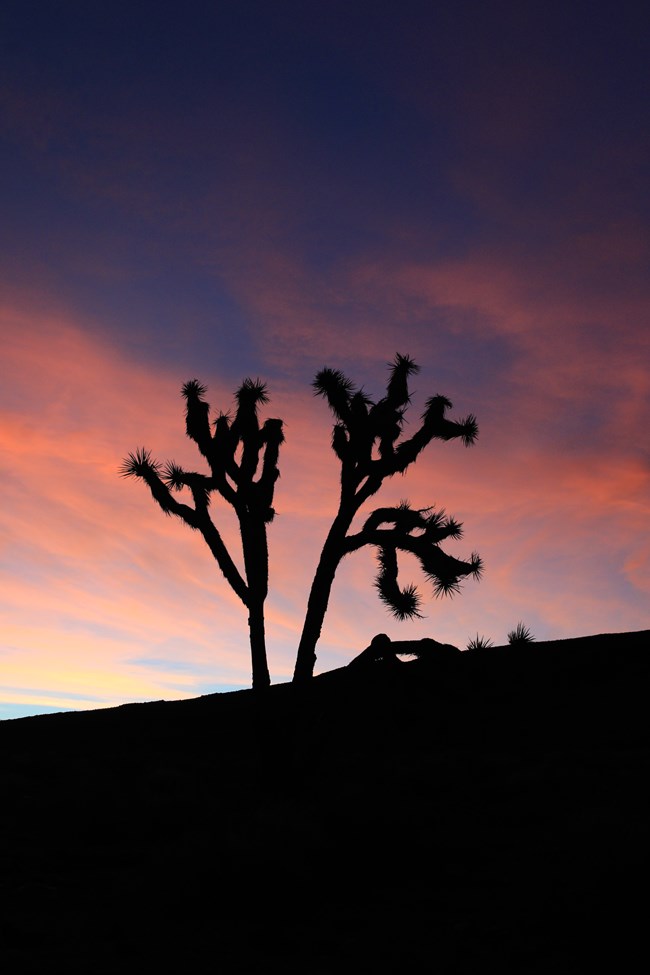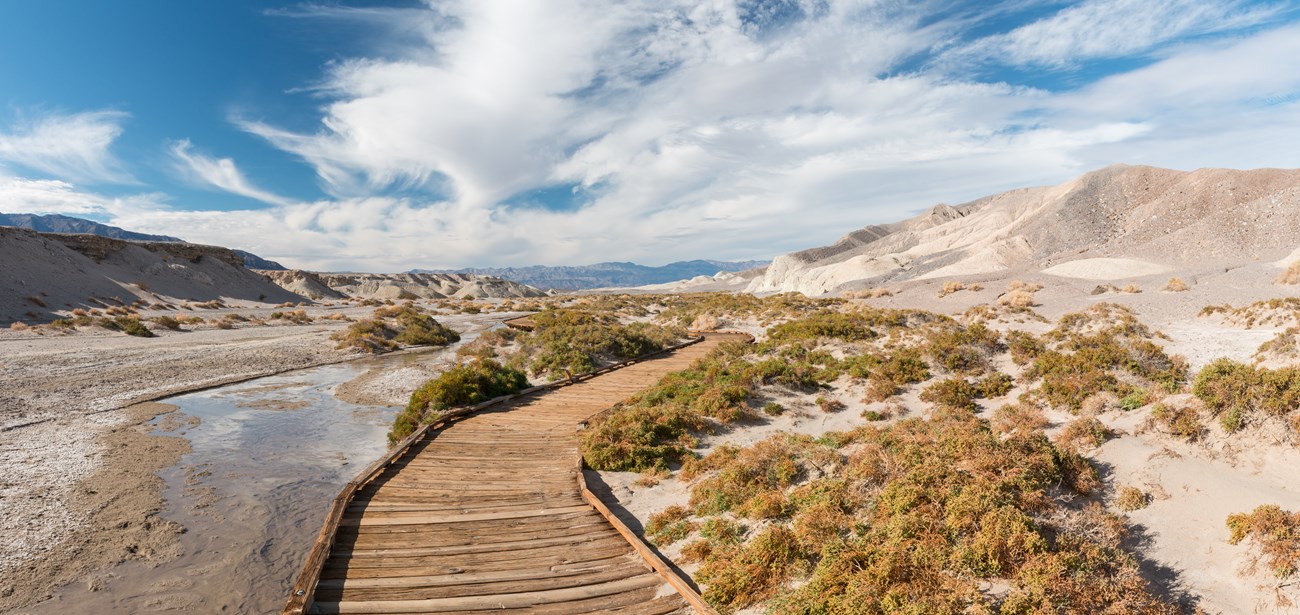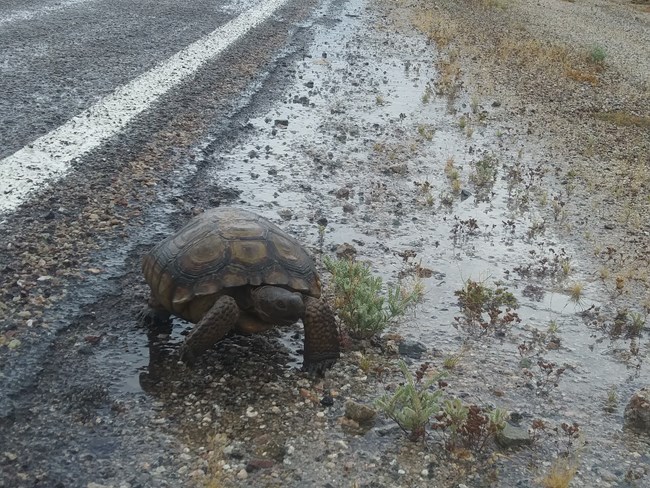Last updated: June 29, 2024
Article
Beyond the Surface: National Recognition of the California Desert

NPS/Kessler
A Diversity of Life
Death Valley and Joshua Tree National Parks and Mojave National Preserve are scientific laboratories for studying geology, paleontology, wildlife biology, ancient soil crust, and even life on distant planets. They provide habitat for a diversity of plants and wildlife; some that are found nowhere else. California deserts are sacred to certain Native American tribes whose ancestors lived there. Death Valley is the homeland of the Timbisha Shoshone.
Over 10,000 years ago, dry lake beds or playas were filled with ancient lakes. Megafauna such as dire wolves, large camels and giant ground sloths roamed the landscape. The sloths helped spread Joshua tree seeds through their dung, which extended the range of these yucca trees. Fossilized rocks and wood rat middens reveal evidence of these ancient life forms.
Slow to Get Recognized
Despite these unique resources and stories of the past, desert parks were overshadowed by the iconic Yosemite and Yellowstone. Desert parks do not have waterfalls or giant trees. Their wildlife is mainly nocturnal and hard to observe. The deserts are stark and desolate compared to the greenery and trees of more temperate environments.
It was not until the 1930s that Death Valley and Joshua Tree gained some official recognition as national monuments. The Pacific Coast Borax Company put Death Valley on the map with its famous 20-Mule-Team logo that became a household name in laundry detergent. When mining borax was no longer profitable in Death Valley, the Borax Company tried its luck in the tourism business. In 1927, the Company built a hotel at Furnace Creek. Stephen Mather, who led the marketing campaign for the Pacific Borax Company became the first director of the National Park Service.

NPS/Hoerner
Discovering the Desert
After WWII, new technology led to the development of all-terrain vehicles. Death Valley and Joshua Tree were seen as playgrounds for recreation. At the same time, the population in the metropolitan areas of Los Angeles and Las vegas exploded. Urban residents wanted alternatives to overcrowding and rising costs of city life. They found them in small desert outposts, where living was less expensive. The lack of regulations due to the remoteness gave them a sense of freedom. At the time, deserts were seen as places to dump waste or test atomic bombs. There was a lack of understanding about protecting natural and cultural resources.
The environmental movement of the 1960s and 1970s helped bring more of an awareness to ecology and the unique landscapes in the California desert. Rather than mention the Mojave, Great Basin or Sonoran Deserts, conservationists referred to all areas as the California desert. They saw Joshua Tree, Death Valley and what would become Mojave National Preserve as one desert that was part of a unique and interconnected ecosystem. Their rallying cry was: "One Desert, One Tortoise, One Chance." This ultimately led to one of the largest land conservation bills ever passed-the California Desert Protection Act.

NPS/Kessler
A Significant Act
The California Desert Protection Act was signed into law by Bill Clinton on October 31, 1994. The Act converted Death Valley and Joshua Tree National Monuments into National Parks, added more land to both sites, and established the 1.6 million-acre Mojave National Preserve. It was unprecedented, setting aside over nine million acres of Wilderness.
The passage of the Act took 8 years from the time it was first introduced. In 1970, Russ Penny, California State Director of the Bureau of Land Management (BLM) stated: "the California desert, your desert, is on the brink of environmental disaster." Working with scientists, academics, and federal employees, Penny documented desert resources and mapped sensitive areas. In 1976, Congress passed the Federal Lands Management and Policy Act (FLMPA) which empowered BLM to recommend areas it deemed worthy of wilderness status. In the 1964 Wilderness Act, only the National Park Service, US Forest Service, and Fish and Wildlife Service could recommend wilderness areas to Congress and the president. FLMPA, as it became known, was a huge win for wilderness advocates, since BLM manages over 60 percent of public land in the United States.
Concern for protecting the desert was growing. Along with the passage of FLPMA, 1976 marked the bicentennial of the United States. Barstow residents, Peter and Joyce Burke wanted to do something special for this momentous occasion. Both had a deep connection to the Mojave Desert and wanted to see it protected. They decided to start an advocacy organization called Citizens for a Mojave National Park. It is also around this time that the Sierra Club formed a Desert Committee Group focused on advocacy for the study and preservation of the desert. It sponsored many outings with the hope of increasing the ranks of those who wanted to see the desert protected.
In 1980, BLM adopted the California Desert Plan, which was a blueprint for managing the Mojave Desert and surrounding areas for multiple uses. Sierra Club members and other conservationists felt the provisions permitted recreation at the expense of preservation. The plan rejected the notion that the then East Mojave National Scenic Area (largely today's Mojave National Preserve) should be considered for national park status. It also excluded certain scenic and sensitive areas from consideration for wilderness designation.
Motivated by what they saw as a weak Desert Plan, the Sierra Club and other conservationists pursued legislation to pemanently protect the Mojave Desert. In 1986, Senator Alan Cranston introduced a bill for a California Desert Protection Act. The local media got involved and protests ensued with those for and against the Act. The Act did not move beyond the Senate. Those who wanted to see California desert parks protected fought harder. Death Valley Superintendent, Ed Rothfuss formed a Desert Council where staff from surrounding desert parks could leverage efforts for financial resources and official recognition. This was helped by media attention focused on the desert tortoise.

NPS/Clark
An Iconic Reptile
In 1990, the US Fish and Wildlife Service's listed the desert tortoise as a threatened species under the Endangered Species Act of 1973. Habitat fragmentation, diseases from domestic tortoises, vehicle deaths, and raven predation all seriously threaten the survival of desert tortoises, which can otherwise live for up to 100 years.
Baby desert tortoises were one of the most powerful lobbyists for the California Desert Protection Act. Desert advocates Elden Hughes and Patty Carpenter took these iconic reptiles on a flight from California to Washington, D.C. When the stewardess told them that "their pets would have to go in cargo," they responded "They aren't pets; they are lobbyists." While desert tortoises were lobbying for protection of their habitat in Washington, Sierra Club member, Judy Anderson led a group responsible for mapping the Mojave Desert to show the varied landscapes and fragile resources.
After several studies, lobbying efforts, and numerous revisions to Cranston's initial Protection Act bill, it became law in 1994. Senator Dianne Feinstein made over 50 revisions to the bill to get it passed by those who initially opposed it. In a near miss, the last vote to pass the bill (a minimum of 60 is needed in the Senate) came late, when Illinois Senator Carole Moseley-Braun, delayed by a faulty garage door opener rushed into Chambers late and cast her "aye" vote. The ultimate compromise that secured the bill was proposing that Mojave be established as a national preserve instead of a national park, where hunting and grazing were permitted.
The California Desert Today
Today, the Mojave Desert parks have an unprecedented number of visitors, even in the searing summer heat. Many visitors who travel to Joshua Tree and Death Valley National Parks and Mojave National Preserve have never heard of the California Desert Protection Act. To some visitors, the desert is still a place to drive through on the way to somewhere else. Others, however, who have spent time hiking through Joshua trees, walking out on the salt flats, or spotting bighorn sheep on a distant peak, find life in a seemingly desolate place.
